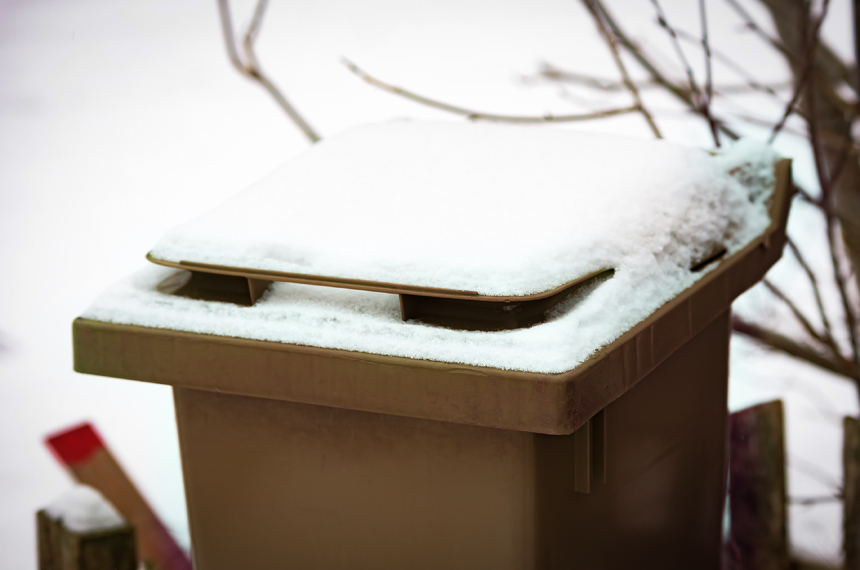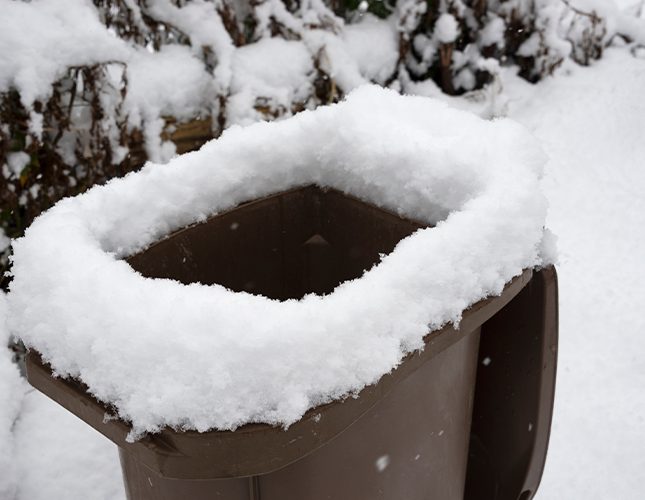A few tips to be the perfect recycler and composter during the cold season
What to do with a compost that is too wet in winter? Which compost bag should you use in winter? What can be done to ensure that the collection of residual, organic or recyclable materials is optimal when it is minus thirty degrees outside? The cold sometimes complicates our normal operations and we have to adapt! Here are a few tips to manage your blue, blue and black bins in the winter and help our team empty your bins completely.
How to prevent compost from freezing in winter
When the material decomposes, it can produce liquid. In addition, wet or soft materials can be placed in a composting bag (if your municipality accepts). When it is full and deposited in your frozen brown bin in winter, the soaked bag can stick to the walls of your brown bin and freeze. This is why sometimes your composting bags end up forming a big ice cube in your brown bin that it is impossible to peel off during collection. The phenomenon of too wet compost in winter can be reduced by following a few simple tricks:
- Avoid putting liquids or organic materials that are too soft in your composting bag. Empty liquids in the toilet or kitchen sink and wrap soft organic matter in newspaper to prevent them from dripping into the bottom of your brown bin.
- Choose biodegradable recycled paper bags designed with a natural cellulose lining that make them leak-resistant. There’s nothing better to deal with a compost that’s too wet than a paper bag. It is not recommended to throw directly into the bin your organic matter that will freeze very quickly whether in winter or summer. As for plastic bags for composting sold in shops, they are refused in most cases in municipalities. In addition, if they are drilled, they spread all their contents in the bin that freezes almost instantly in winter.
- Insert newspaper or cardboard, such as loose boxes, into the bottom of your brown bin. If bags were to leak, the liquid would be absorbed by the paper or cardboard and would not stick your compost bags to the bottom of the bin, making it difficult to collect.
- If you can, place your brown bin in a heated area, such as your garage, to prevent the contents from freezing between collections.
- Still if you have the capacity, you can freeze your materials directly in your freezer, which will eliminate the possibility that they freeze in the bin… already freezing!

How to maintain bins in winter
Maintaining our bins in winter is not rocket science. Just use the same rules as your car! You think we’re laughing? See!
- Just like your car, clear the top of your bin. This is a traffic safety violation when you are driving a vehicle that has not been properly cleared of snow and a wellness violation for your bin as recyclables will be mixed with snow at the sorting centre. which not only freezes the hands of our sorters, but can damage our machinery when ice mixes in.
- Remove snow from the bin. Like your car, our truck needs space to move. We recommend clearing three feet around your bin, whether it’s snow or another vehicle. The goal is to safely collect your brown, blue and black bins!
- Do not place your bin on the street. In winter, with snow removal, it is convenient to park your car in a parking lot…especially when there is a snow removal operation! It is also convenient for us that you place, if possible, your bin in your entrance and not in the street.
Let’s keep up the good work
Too wet compost should not discourage you from using your brown bin in winter. You should also keep your good habits and recycle in the winter as well. Just take care of your bins as you take care of your car in the winter. It is all together, with each of our actions, that we can make the work of companies like Ricova that works all year round to get to the right places for upgrading, if necessary, your materials, easier and more efficient.
Do not hesitate to contact us if you have any questions:








